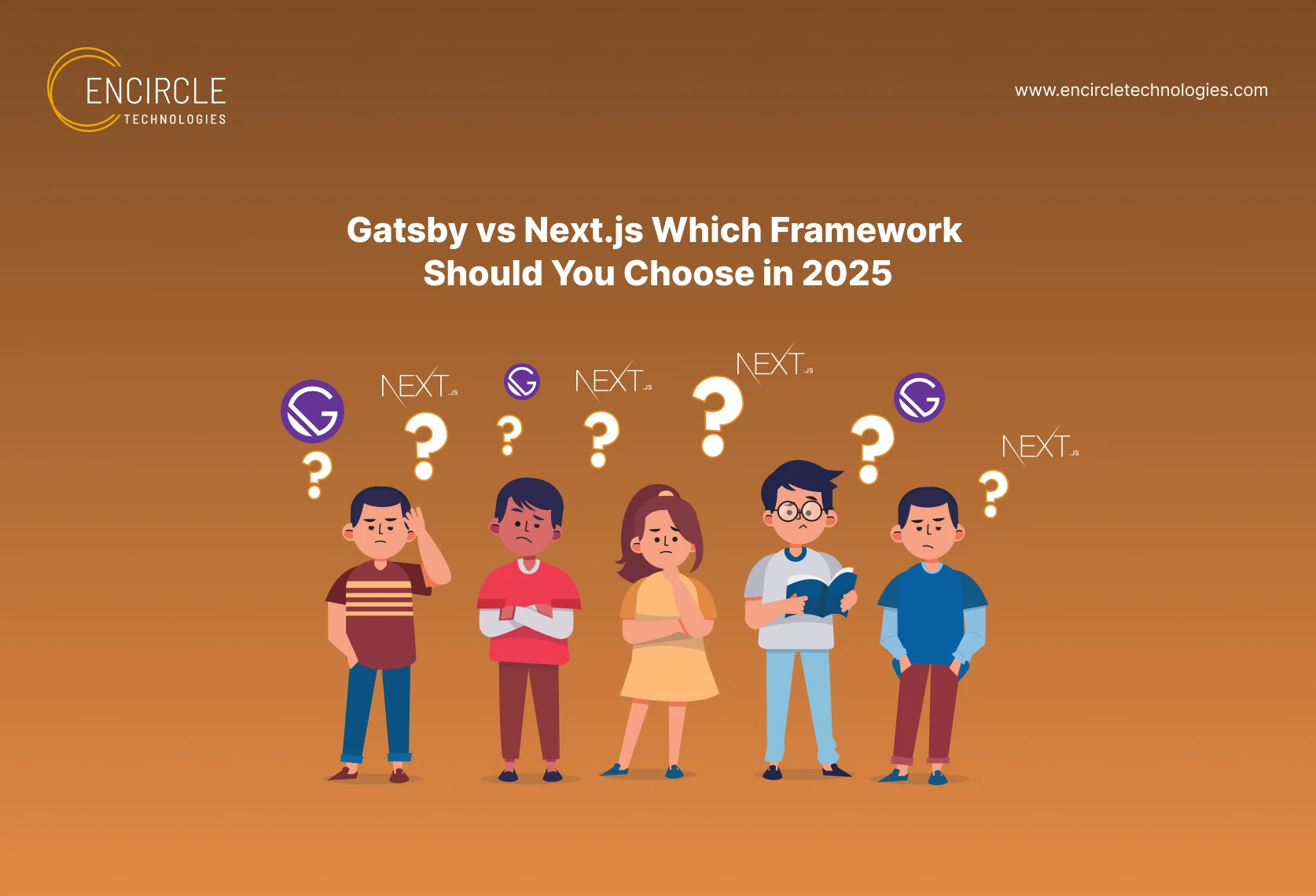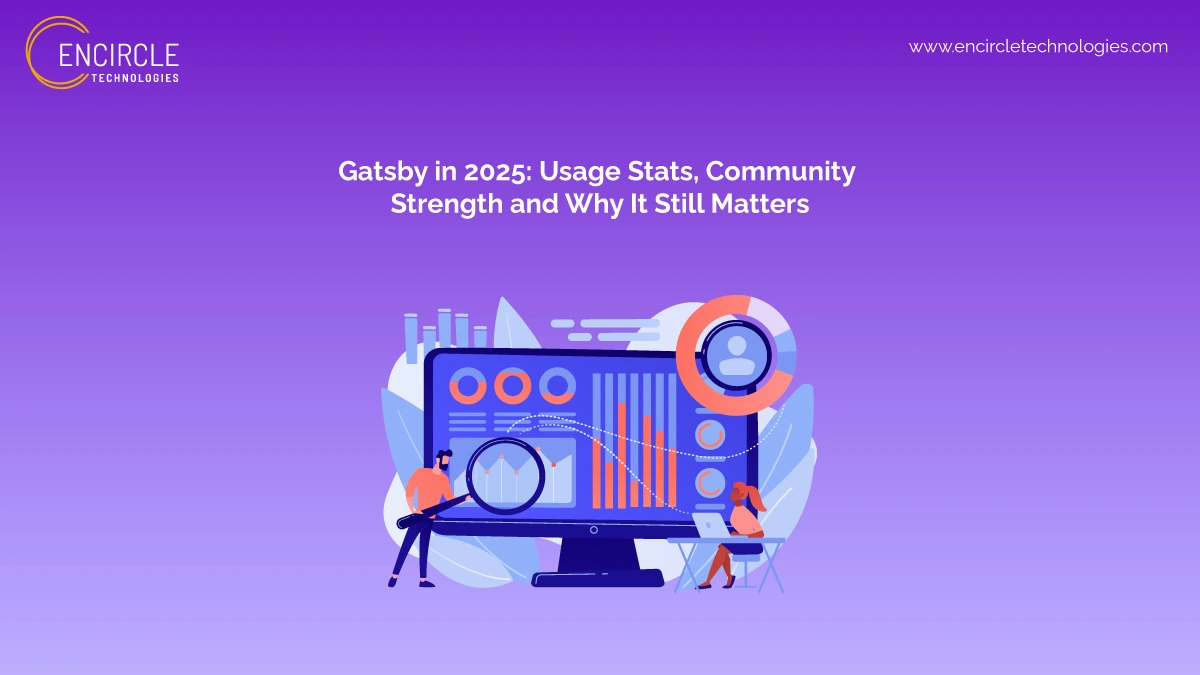
The entire landscape of frontend development has seen a drastic change, with the modern website being expected to be incredibly fast, secure, and suitably interactive. Developers are hence straying from the usual setup toward advanced frameworks that reduce the load time and provide a better user experience. In the current digital landscape, optimal performance has transitioned from an advantage to a baseline expectation at all times.
React-based frameworks such as Gatsby and Next.js have led to this evolution. Developers take advantage of the technologies in building highly scalable, maintainable, and responsive web applications that suit their business needs perfectly.
Picking the right framework, therefore, in 2025, does not mean just coding convenience; it also affects how fast your website loads, where it ranks on Search Engines, and its efficiency in scaling. According to research, a 20% reduction in conversion was registered for every single second of delay in page load time, hence making performance development a key consideration.
Collaborating with a professional GatsbyJS development company ensures that your site is fast, secure, and built for future growth and efficiency.
Overview of Gatsby and Next.js
What is Gatsby?
Gatsby is a static site generator built over React that renders website content into pre-rendered HTML at build time. It is specially created for speed, security, and SEO. And by turning the content into static files, Gatsby ensures the websites load instantly and remain performant through time.
Gatsby stands for out-of-the-box performance optimizations. Included are image compression, lazy loading, and code splitting, and it is perfect for very high-speed websites with very little setup. Its powerful plugin system allows it to interface with almost anything-a CMS, an API, analytics, and more.
What is Next.js?
Next.js is an all-in-all simply exquisite React framework that supports full-stack development. It does not limit things to static content generation, as Gatsby does. Next.js seamlessly integrates rendering modalities such as Static Site Generation (SSG), Server-Side Rendering (SSR), and Incremental Static Regeneration (ISR), all while supporting full-fledged API routes, consolidating diverse needs within a single ecosystem.
Next.js gains more adoption because of its enterprise-level sponsorship from Vercel. Being more performant, scalable, and having a great developer experience, it fits dynamic websites, applications with personalized content, and large-scale platforms.
Key Features Comparison
➥ Rendering Capabilities
Rendering methods are one big difference when considering Gatsby JS vs Next JS. Gatsby mainly deals with Static Site Generation (SSG), pre-building everything into static HTML files. This suits content that hardly changes.
Its collection of rendering models - SSG, SSR, ISR, and client-side rendering - equips developers with the versatility to match delivery mode to workload and performance target. These conditions give developers more control over when and how content gets generated, which is useful, especially if the application requires immediate data or quick updates.
➥ Performance
The target for both implementations is the same, potentially high performance, while each achieves it differently. Gatsby wins by offering static asset pre-optimization and is suitable for static sites such as blogs, portfolios, or landing pages.
Conversely, Next.js's hybrid rendering model often emerges in the discussion of Next.js vs. Gatsby. Next.js can statically generate pages for public usage, while an SSR mechanism serves a personalized dashboard or login area, rendering better performance to large, highly dynamic applications.
➥ Data Fetching
Gatsby employs a centralized GraphQL-based data layer, allowing one to pull content from various sources and query in a single schema. Powerful yet difficult for teams who have not used GraphQL.
Next.js performs data fetching in a more straightforward way by using native React methods such as getStaticProps, getServerSideProps, and getInitialProps. This straightforward approach is lovely for those who have been using the React component model.
➥ Build Times
Build times are another consideration when comparing Gatsby vs. Next.js. Gatsby, while blazing fast when supporting sites of small to medium size, generally encounters long build times when the number of pages grows, especially when trying to deal with media richness or dynamic content.
Next.js solves this using Incremental Static Regeneration (ISR), which allows developers to regenerate pages on demand rather than during a full rebuild, thereby ensuring downtime serves much less than under the full rebuild. Hence, this is really important for projects that are very large or frequently updated, where the build time is immense.
➥ Developer Experience
Gatsby is excellent for smooth onboarding, coupled with its smartly made CLI and wide library of starters. But it does require the extra setup when adding in dynamic features like users' authentication or custom APIs.
Next.js promises an intuitive developer experience right from the get-go. Its file-based routing, native API routes, and full-stack support bestow it with the grace to be used for a full-fledged application, without resorting to additional tools.
Use Case Scenarios
When To Use Gatsby?
Gatsby works best as a solution for static sites containing a lot of content that rarely undergoes changes. Examples include blogs, documentation sites, portfolio sites, and marketing sites that serve static content as their mainstay.
If fast loading times and highly structured content dominate the objectives of SEO projects, this would be a great choice. Pre-rendering and tag control make Gatsby one of the SEO-friendly implementations.
Also, if teams have comfortable experiences with GraphQL and plan to deploy their sites using static hosting environments such as Netlify or GitHub Pages, Gatsby is a great choice.
When to Use Next.js?
Next.js is perhaps considered the framework for dynamic content with user interactivity. Product platforms of eCommerce, SaaS dashboards, and personalized user portals rank highly to benefit from SSR and ISR capabilities.
It lends itself well to scenarios where your team implements full-stack apps with custom backend logic. For such use cases, Next.js gives the right flexibility via built-in API routes and serverless deployment support.
To summarize, whenever your application needs to pull real-time data, allow user authentication, or scale dynamically, Next.js is a better option.
Pros and Cons
Gatsby Pros
● Lightning-fast performance is achieved through pre-rendering static pages.
● It has a plugin ecosystem that covers SEO, images, CMSs, and more.
● Perfectly suited to content-focused projects with regular content updates.
Gatsby Cons
● Build times may become slower for sites that are huge in scale and contain large amounts of dynamic data.
● Not optimized for real-time or user-specific content without additional setup.
● Complexity may increase for teams with the GraphQL requirement.
Next.js Pros
● Full Static Generation, on-demand SSR, and ISR operate side by side, accommodating a spectrum of content pace.
● API routes provide the freedom to avoid integrating with external backend services
● TypeScript is woven throughout the framework, and a rich, polished toolkit enhances the developer experience from the outset.
Next.js Cons
● Higher learning curve for a beginner who is not used to full-stack.
● Requires manual tuning for optimization to reach the static level in some cases.
What's New in 2025?
➥ Gatsby 5+ Updates
With advanced incremental build techniques, Gatsby 5 and later updates improve build times significantly. This means that developers now have a much faster deployment cycle, even for purely content-heavy sites.
The plugin ecosystem of Gatsby continues in its evolution with newer integrations that improve optimization of images, CMS compatibility, and performance at the edge.
➥ Next.js 14/15 Features
Innovative Next.js versions 14 and 15 now better support React Server Components, improving the server-client separation of content.
Alongside this, it continues to improve the app directory for more flexible routing and component organization. Improvements to Middleware give developers control over caching, auth, and personalization at the edge.
Choosing the Right Framework for Your Project
➥ Evaluate the Project Requirements
Begin by categorizing your content as primarily static or dynamic, as this will inform your architectural choices. Static content can be handled well by Gatsby's SSG, whereas dynamic apps that need simultaneous changes benefit from Next.js.
Determine whether the prospective project demands APIs, dashboards, or even real-time functionality, which is an excellent alignment for Next.js.
➥ Consider Your Team Skills and Workflow
Do you prefer GraphQL or REST APIs? Gatsby means GraphQL, whereas Next.js gives a little more freedom with the data source.
Also, see if your developers get a kick out of handling backend logic and serverless functions, as these fit in more tightly in Next.js workflows.
➥ Think Long-Term Scalability
Scalability should germinate the thought process as you make your choice. Gatsby will have cheaper hosting due to its static nature, but may hit the wall in the long run with increasing complexity.
Next.js, on the other hand, truly comes into its own for enterprise-grade applications, where a scalable architecture featuring edge computing, dynamic routing, and serverless functions is required.
Gatsby or Next.js - The Right Choice Depends on Your Needs
There is no perfect answer for this question, as each framework boasts strong suits depending on the particular job at hand. GatsbyJS development services work best for projects that focus on performance and serve static content, like blogs, marketing sites, or documentation platforms. Gatsby offers instant load times and a big SEO advantage by way of pre-rendered pages.
Being a very web-friendly framework, Next.js does well when the app is dynamic with gobs of data that needs server-side rendering, API integration, or user authentication. Basically, dashboards, SaaS platforms, or eCommerce websites.
Whatever way the ride takes you, it should depend on the needs and technical capabilities, scale, and complexity of your project, not what others have done. Align your selection with strategic objectives to ensure the chosen technology grows in tandem with your organization’s aspirations.

support@encircletechnologies.com
Encircle Technologies is an IT company specialising in the Web and Mobile app development services for all types of businesses; small or large, for all business verticals, across the world. We’re proud to say that our team has worked with some truly incredible partners over a short period of time.




